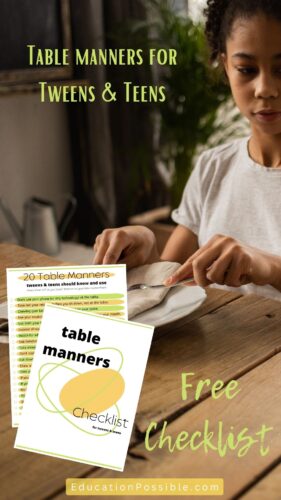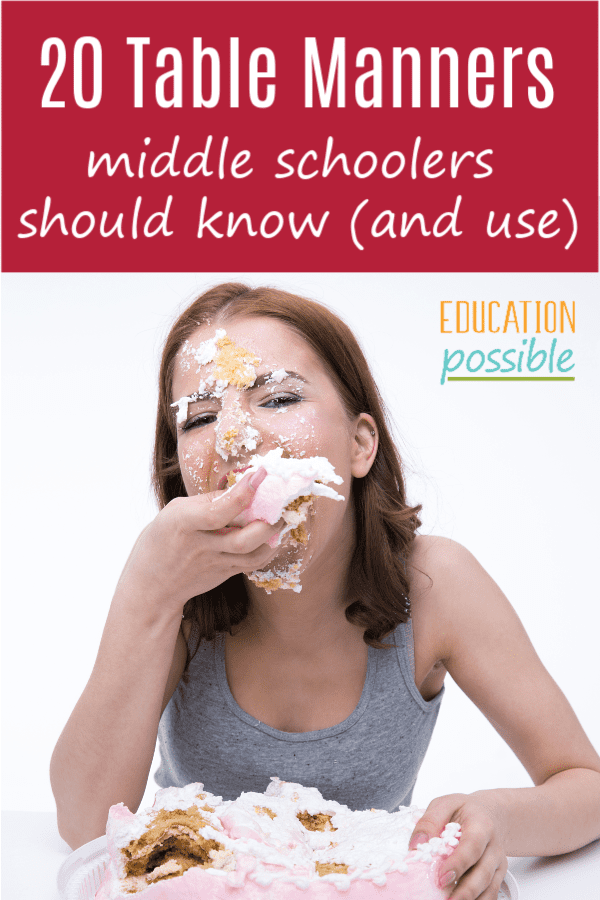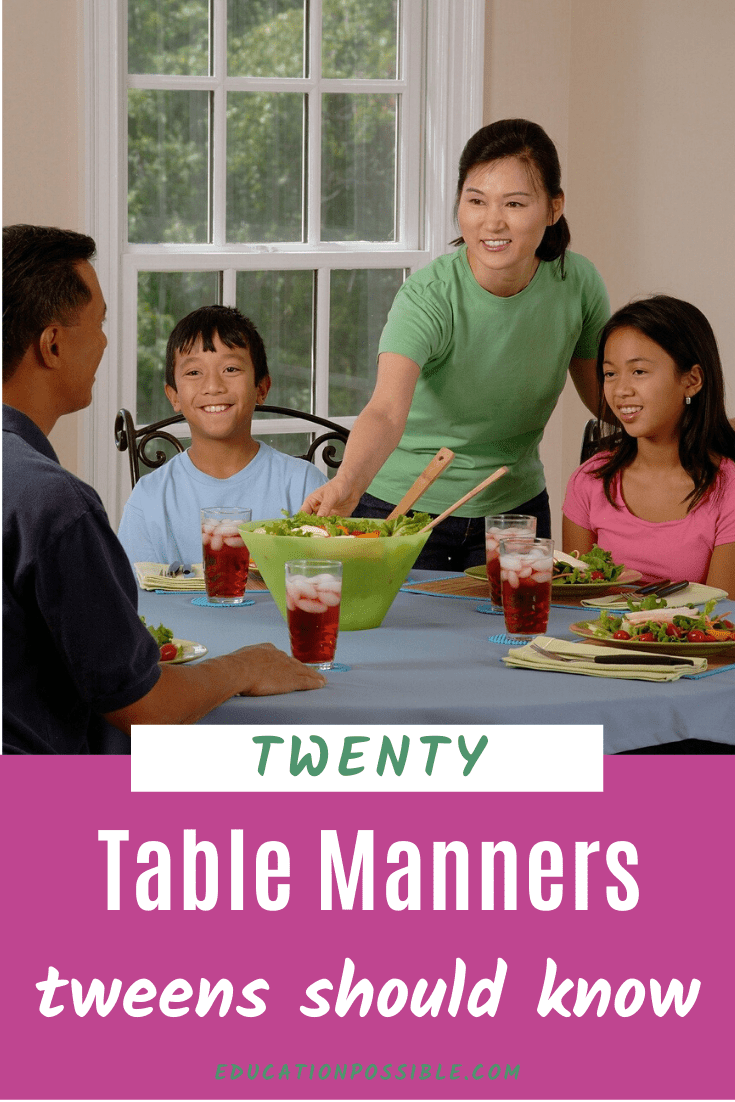20 Important Table Manners for Teens and tweens
Table manners for teens and tweens are some of the life skills we need to make sure our older kids master.
It’s easy to think this subject is just for little kids because good table manners are some of the earliest skills we teach them. However, there is always room for improvement. Once they’re in middle school, it’s definitely time to move beyond basic table manners.
When you’re working on etiquette with your middle schooler, the best thing to do is to keep it simple.
It’s important for older kids to understand that when they use proper table manners, meal time is a pleasant experience for everyone.
Teaching etiquette is an important part of parenting, so use this time as an opportunity to have fun with your middle schooler while modeling the behavior you expect from them.
Table Manners for Teens
If you’re feeling a bit lost where to start with teaching table manners to your older kids, here are 20 things that older kids should know, understand, and use when they’re at the table for a family meal.
Start here and once your teens masters these, move on to even more advanced table manners. It’s easy to fall into bad habits, so it’s important to remind your kids why this stuff matters.
I’ve even included a helpful checklist as a great reminder and to make it easy to keep track of the skills you’re working on. It’s at the bottom of the page.
Why are Table Manners Important?
Middle schoolers need to know proper table etiquette for a few reasons.
- Manners are a great way to show respect for others.
- They’re a way of being polite and considerate.
- They help to make sure everyone enjoys their meal.
- Basic manners are a way of showing appreciation for the food that is being served.
The last thing you want is for their poor table manners to embarrass themselves or their hosts when you’re not there to correct them.
That’s why kids should be taught a wide variety of social behaviors from a young age and reinforced with constant reminders and practice.
How to Teach Table Manners
If you have a tween who lacks table manners, don’t worry – it’s entirely normal!
Start by discussing which manners they should know and why it’s important to use them in certain situations. Then, practice the basics and be sure to give lots of praise when they use their manners correctly.
The best thing is to keep an open dialogue about the topic. Give gentle reminders if needed, but try to keep it lighthearted and remember that making mistakes is part of learning.
In order for tweens and teens to feel comfortable when dining with someone other than family, like dinner at a friend’s house, at social gatherings, or in a more formal setting, they need to practice their table etiquette.
Remember that manners aren’t something people are born with, they’re a skill that takes practice. So it’s time to step up the training and expect a bit more from your tween during family dinners.
And keep in mind that when you’re teaching tweens table manners, the whole family should model proper etiquette – including mom and dad.
Eventually they’ll get it right.
Don’t forget that there’s a FREE checklist at the end of the post to help you teach these 20 table manners for teens and tweens!
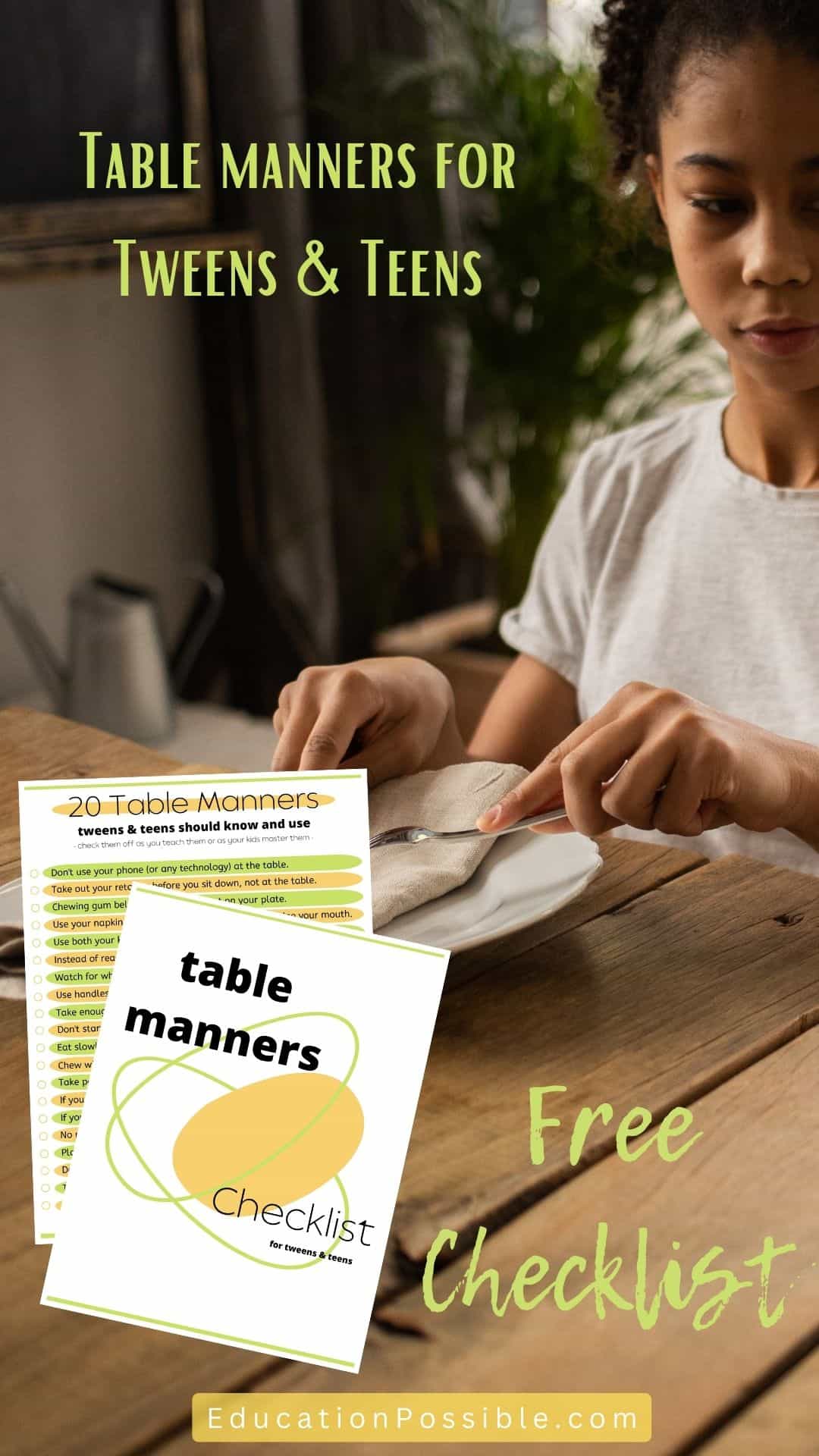
Table Etiquette for Kids
Work through this list with your older children so they can learn how to be an awesome table mate.
1. Technology at the Dinner Table
Do not use your phone or other electronic devices at the table. Keep them put away. If possible, don’t even bring them with you.
Remember that video games don’t belong at the meal table. It’s rude to focus on your phone, essentially ignoring the friends and family who are sitting at the table with you.
You may suffer from separation anxiety, but no, you won’t die.
2. Should You Remove Your Retainer at the Table?
No. Don’t take out your retainer at the table. Period. Remove it prior to sitting down to eat.
After you’re finished, don’t put it back in until you have left the table.
3. Chewing Gum Etiquette
If you’re chewing gum, the best thing to do is to throw it out before you sit at the table.
Gum belongs in the trash, not on the edge of your plate, in your napkin, and definitely not on (or under) the table.
4. Using Napkins at the Dinner Table
Whether your napkin is sitting neatly next to your plate or folded into a beautiful fan or swan, you need to unfold it and put it on your lap when you sit down. Or, if you’re at a dinner party, pick up your napkin after the host does.
Make a point to use it to wipe your mouth as you’re eating. Remember, sleeves should never take the place of a napkin.
When you finish eating or get up to leave the table during the meal, place your napkin to the left of your plate or on your seat.
5. Knife and Fork Etiquette
Tweens may ask, what’s with the silverware? Once they know how to set the table, it’s time to make sure they know how to use the utensils.
If there is more than one fork or knife in your place setting, start with the furthest one and work your way inward with each course.
You should use both your knife and fork to cut your food instead of trying to saw through things with the side of a fork.
When you are not using your fork and knife, place them on your plate in an upside-down “V” shape.
Oh, and never use your silverware as a weapon – real or pretend.
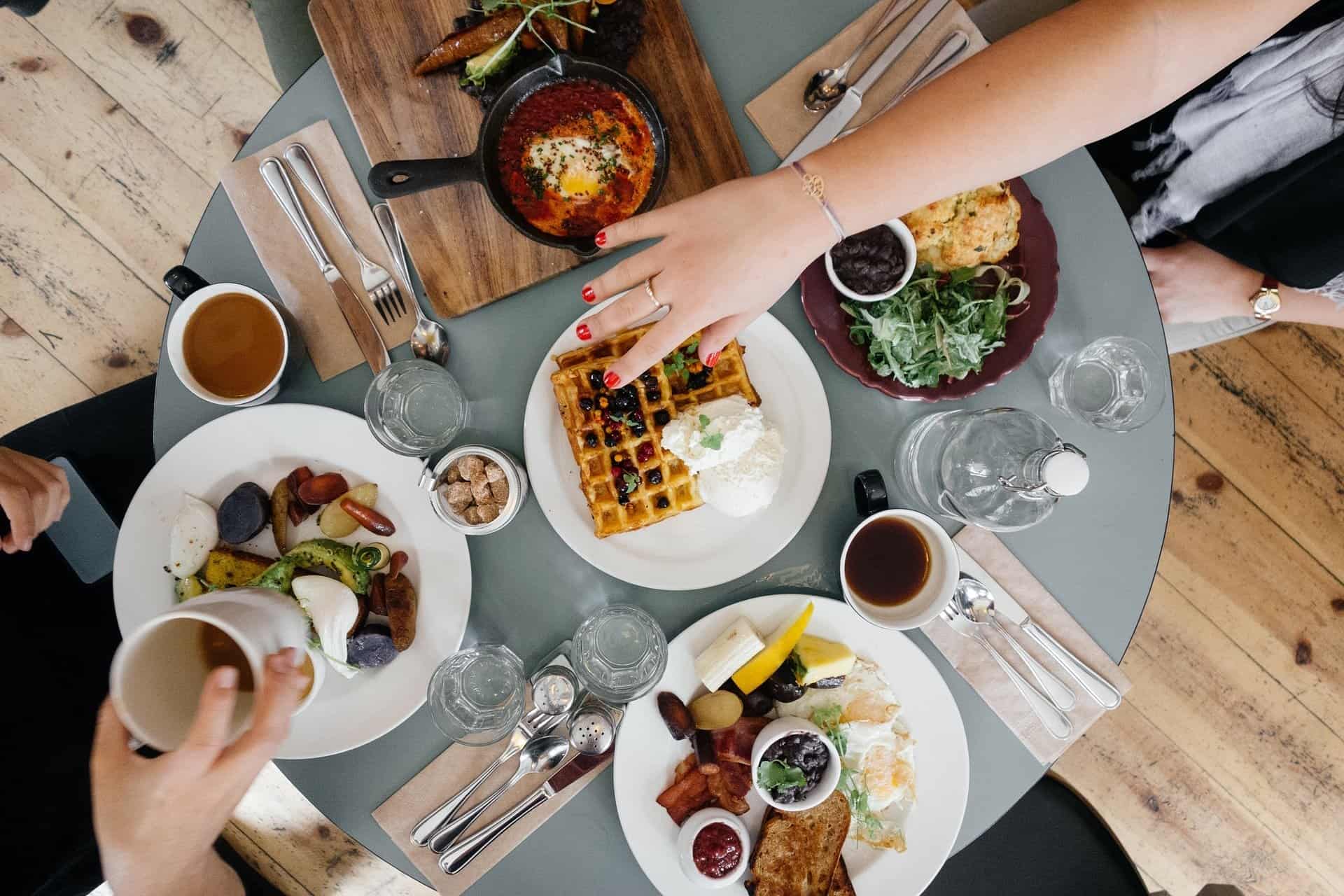
6. Reaching Across the Table
Can I reach it? How far is too far to reach for food?
If you can’t reach it with your arm straight out, leaning slightly forward, it’s too far. If someone has to lean back when you are reaching, it’s too far.
Instead, say “please pass the ….”
7. How to Pass Food at the Table
When passing platters of food, pass to your right. If someone starts passing platters the opposite way, just follow along. Remember, the goal is to be polite.
Also, keep in mind, it’s not a race. If the person next to you already has a platter in their hand, don’t make them hold another one. The best approach is to be patient and wait for them to finish.
8. Passing Dishes with Handles
The general rule about passing dishes is that if it has a handle, use it. Take note to pass it with the handle out so the person can easily grasp it.
Don’t make them grab the main part of the dish because it could be hot and could burn them. That’s why it has a handle.
9. Leaving Food for Others
When the food reaches you, take your helping, but make sure to leave enough for others. We know you’re a tween and you’re starving. You’re always starving.
You can have seconds or thirds of small portions. Just give everyone else a chance.
10. Wait for Everyone to Be Served Before Eating
Should you wait for everyone to get their food before you start to eat? Yes.
At the beginning of the meal, don’t start eating until everyone is seated and served, unless your host specifically tells you to begin.
It is good manners to wait until everyone has gotten their food before you eat.

11. Don’t Take Huge Bites
It’s impolite to shove a large amount of food into your mouth.
When you stuff your face, it’s likely that you won’t be able to chew with your mouth closed, plus, it will take a very long time to chew and swallow everything.
So, remember to eat small bites that are manageable.
One way to help with this is to cut one or two small pieces of food at a time. It will keep things from getting cold and limit the chance that you will scarf down your food.
12. Chew With Your Mouth Closed
Please, no “see food” at the table.
Chewing with your mouth closed is a basic part of table manners.
No one wants to see the food you’re eating. So please refrain from talking with your mouth full and chew with both your mouth and lips closed.
13. Take Part in Dinner Conversations
Now that you’re older, you are expected to be an engaged, active participant during the meal. That means no slouching, excessive fidgeting, or grunting at people when they ask you a question.
Instead of just sitting there, take part in the conversations going on around the table.
Communication skills are essential for tweens and teens to learn and the dinner table is an excellent place to practice.
14. How to Leave the Table
If you need to leave the table before the meal is finished, the proper way is to ask to be excused or simply say that you’ll be right back.
You don’t have to go into detail. The less we know, the better.
Go back and re-read #4 if you’re unsure of what to do with your napkin.
Take care of your business and return to the table as soon as you’re able.
15. Don’t Complain About the Food
There is a chance that you won’t like everything you’re served, but the polite thing to do is keep those critical comments to yourself.
If you’re served new foods that you don’t like, take a small portion and try to eat what you can. Even picky eaters should show proper etiquette.
Remember that your hostess worked hard to make everything, so go out of your way to thank her, regardless of what you thought of the meal. So keep negative comments to yourself.
If you truly have a food preference (like you’re gluten intolerant or vegan) it is polite to tell your host when you receive the invitation. If there are items on your plate that you can’t eat, quietly eat what you can.
16. No Rude Noises at the Dinner Table
You’d think this would go without saying, but… no burping, farting, slurping, etc. when you’re at the table.
17. What to Do With the Silverware When You’re Done Eating
When you are finished eating, place your fork and knife together on the right side of your plate with the blade facing inward and the fork tines facing up, kind of at the position of 10 and 4 on a clock.
This will signal to everyone at the table (and any waitstaff) that you are done and your setting can be cleared.
18. Freshening up at the Table
Should you freshen up at the table? No. Save the personal hygiene for the bathroom.
You’re beautiful just the way you are. Remember that the table is no place for combing your hair or reapplying make-up.
Just wait until everyone gets up from the table before you head to the bathroom to freshen yourself up or simply excuse yourself for a moment.
19. Don’t Leave the Table Before Everyone Has Finished Eating
If others are still eating or just sitting around talking, take time to hang out, even if you’re finished.
Once you’re done eating, don’t run off never to be seen again. Sit. Talk. Relax.
20. Help to Clean Up
At the end of the meal, help clean up. Clear the table, wash dishes, put food in containers, take out the trash, etc.
I know it’s boring. Everyone thinks it’s boring. That doesn’t mean you shouldn’t help.
Welcome to adulthood.
Obviously, this isn’t an exhaustive list of table manners for teens, just a good, basic starting point for the next step in etiquette training.
By mastering these, your middle schooler will be well on their way to putting their bad manners behind them and becoming rock stars at the dinner table.
Etiquette Lessons
If you’re looking to go further in your etiquette training and don’t want to do it on your own, consider using a curriculum to teach your kids about things like table manners.
We’ve used the Etiquette Factory over the years, and it’s one of our favorites because of their short lessons and interactive activities.
BOOKS ABOUT TABLE MANNERS AND ETIQUETTE
If you are looking for more tools to help your middle schoolers improve their manners (and possibly learn some more) add some of these books to your family’s library and use them when you’re teaching life skills in your homeschool.
How Rude!: The Teen Guide to Good Manners, Proper Behavior, and Not Grossing People Out Don’t Behave Like You Live in a Cave
Don’t Behave Like You Live in a Cave Teen Manners: From Malls to Meals to Messaging and Beyond
Teen Manners: From Malls to Meals to Messaging and Beyond Dude, That’s Rude!: (Get Some Manners)
Dude, That’s Rude!: (Get Some Manners)
MORE HELPFUL ETIQUETTE RESOURCES
Are you looking to expand your tweens’ manners this year?
- Writing thank you notes is still important.
- Do your older kids know the etiquette of eating out?
- Old-fashioned skills kids should know.
Don’t forget that you don’t have to figure it out on your own. Use some of the tools I’ve shared here and remember that I’m always here to help. After all, it’s the polite thing to do!
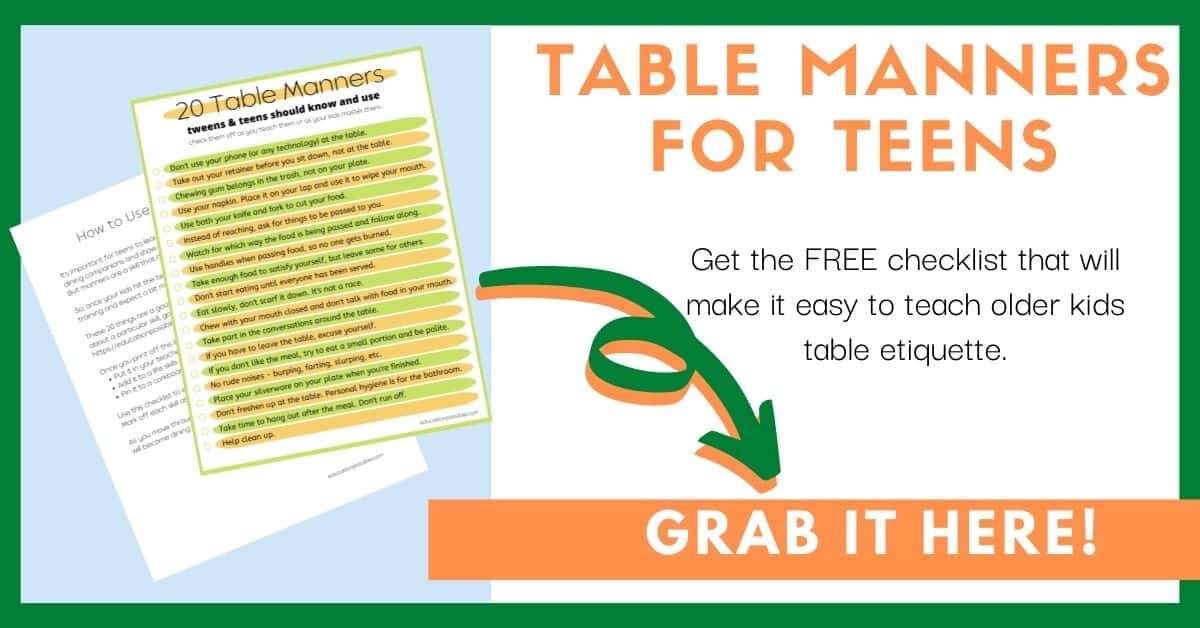
What table manners for teens are you working on?
